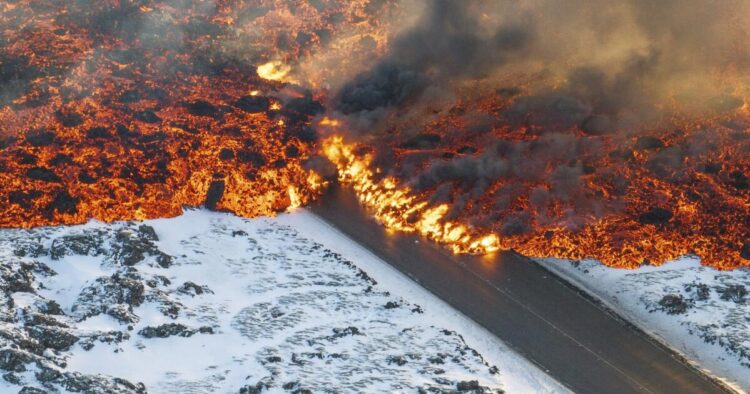A volcano in southwestern Iceland erupted on Thursday for the third time since December, causing jets of lava to shoot into the sky. This eruption triggered the evacuation of the popular Blue Lagoon geothermal spa and disrupted heat and hot water supplies to thousands of people.
The eruption began around 0600 GMT along a three-kilometer fissure northeast of Mount Sýlingarfell, as reported by the Icelandic Meteorological Office. This event cut off several communities on the Reykjanes Peninsula from heat and hot water after a river of lava engulfed a supply pipeline.
Although the eruption’s intensity decreased by mid-afternoon, lava continued to spew from parts of the fissure, and a significant plume of steam rose over a section of the crack where magma mixed with groundwater.
The eruption site is approximately 4 kilometers northeast of Grindavik, a coastal town that was evacuated before a previous eruption on December 18. The Meteorological Office stated there was no immediate threat to the town during Thursday’s eruption.
Officials from the Civil Defense agency mentioned that no one was believed to be in Grindavik at the time of the new eruption. The evacuation was carried out efficiently to ensure safety.
Lava reached a pipeline supplying hot water to several towns on the Reykjanes Peninsula from the Svartsengi geothermal power plant. Authorities urged residents to conserve hot water and electricity as workers raced to lay an underground water pipe as a backup. Schools, gyms, and swimming pools were closed due to the lack of heat and water.
The Blue Lagoon thermal spa, which utilizes excess water from the power plant, was closed upon the eruption’s onset, and all guests were safely evacuated. However, a stream of steaming lava later spread across the exit road from the spa.
Despite the eruption, nearby Keflavik, Iceland’s main airport, reported no flight disruptions. However, hot water supply to the airport was cut off, according to airport operator Isavia.
The Icelandic Met Office had warned of a possible eruption earlier in the week after monitoring magma buildup beneath the ground for three weeks. Hundreds of small earthquakes had been recorded in the area since Friday, culminating in intense seismic activity about 30 minutes before the latest eruption.
Volcanologist Dave McGarvie emphasized that the eruption is “gentle and effusive,” making it highly unlikely to disrupt aviation with ash clouds. Iceland, sitting above a volcanic hot spot, experiences eruptions every four to five years, with the most disruptive being the Eyjafjallajokull eruption in 2010.
Grindavik, located about 50 kilometers southwest of Reykjavik, was previously evacuated in November due to seismic activity. The recent eruptions have caused significant disruption to the town, with defensive walls being breached, buildings consumed by lava, and land sinking due to magma movement.
While no confirmed deaths have been reported, a worker is missing after falling into a fissure opened by the volcano. President Gudni Th. Johannesson referred to the ongoing eruptions as “a daunting period of upheaval” for the Reykjanes Peninsula, suggesting uncertainty regarding the residents’ ability to permanently return to Grindavik.
McGarvie concluded that recent events have challenged the perception of safety in the area, highlighting the possibility of eruptions occurring sporadically for decades or even centuries on the peninsula.

















Comments